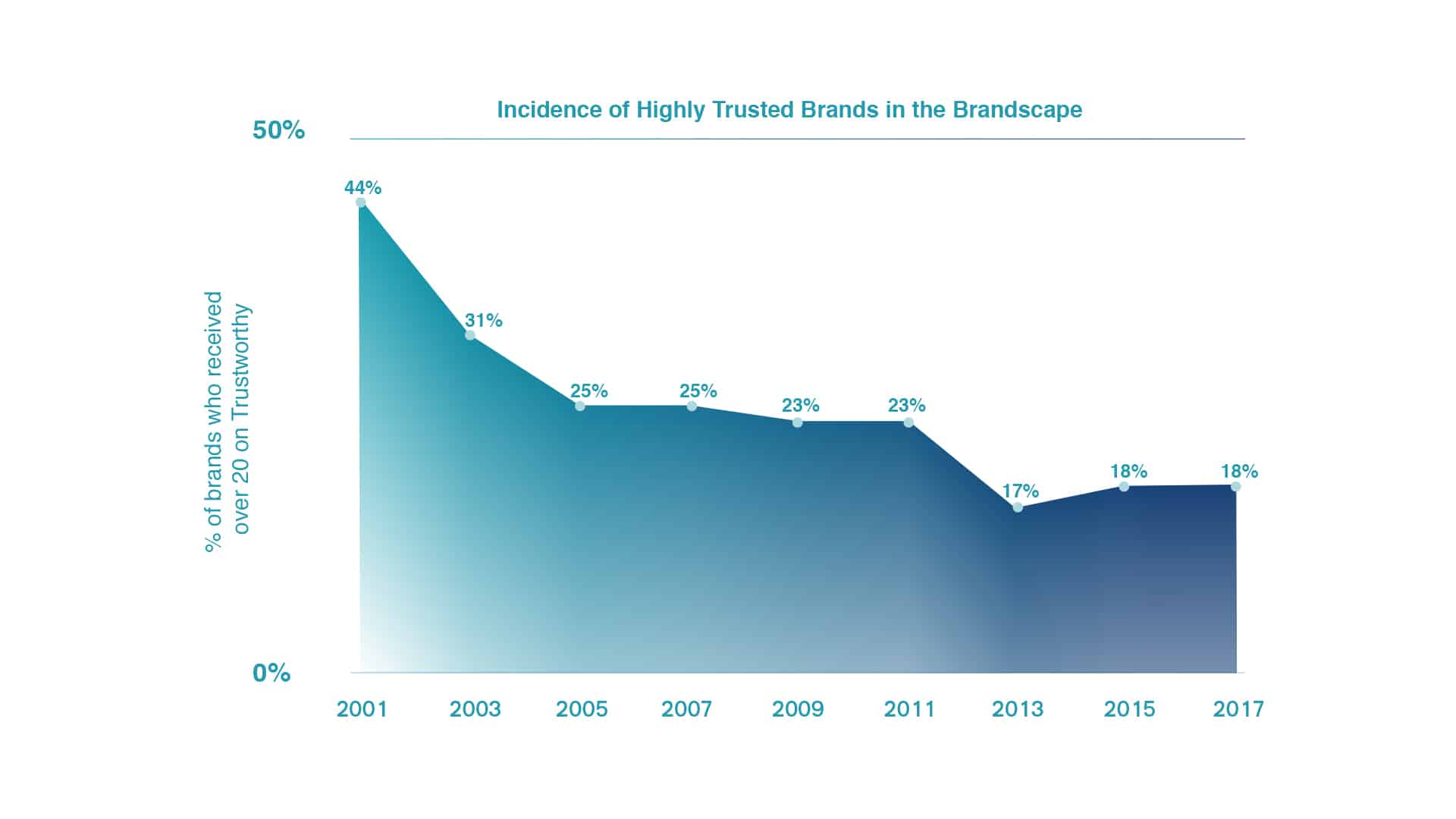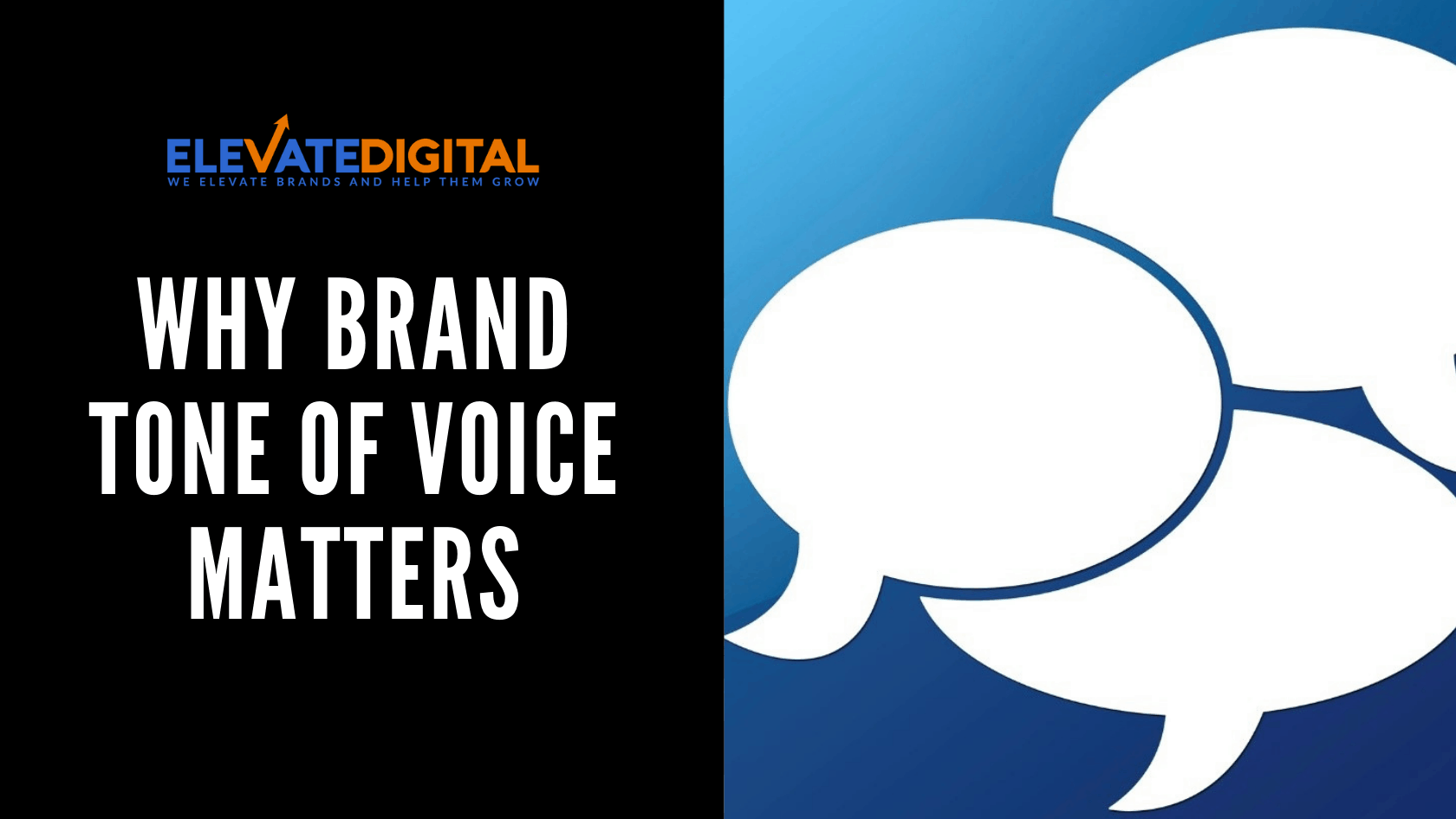In a world full of noise, your brand’s unique tone of voice can be one of the most effective and powerful ways to connect with your audience and really separate yourself from the competition.
Why Tone Of Voice Is So Important
Trust is declining
There’s a reason some of the most loved and respected brands in the world focus so heavily on their tone of voice.
Not only does it allow them to really connect with their customers on a deeper level. But it also removes the veil from the brand.
In a world full of faceless organisations, having a unique tone of voice really allows people to see the humans and the personalities behind the brand.
As you’ll see in this study by BrandAsset Valuator, brand trust slipped from 44% in 2001 to 18% in 2017.
It still continues to do so even today.

You can’t hide online
This chart coincides with the rise of social media platforms and search engines, which made it difficult for brands to hide.
The world we live in is more transparent now than ever before and those who try to “fake it” will soon be exposed.
But what does this mean for the ethical and honest companies out there?
Well the problem is, it can become difficult for the average consumer to tell the difference.
Espeically when every company is communicating using the same generic tone of voice.
Not to mention, the typical style of communication tends to be very cold, un-emotive, inauthentic and rigid.
This usually results in us putting our guard up. Because we feel like we’re being sold to or potentially being manipulated somehow.
This is where the opportunity lies to really stand out and show people that you’re different.
But what if you haven’t established a tone of voice for your brand yet? Well let’s take a look at how you can get started!How To Identify Your Unique Tone Of Voice
There are two critical questions to ask when establishing your brand’s tone of voice.
What does your brand stand for?
The first thing you need to think about when developing and identifying your own tone of voice is who you are as either an individual/organisation and also what you want to be known for.
This all comes down to knowing and getting clear on your brand values.
What are you all about and what do you stand for?
Are you a fun, light-heated and passionate company? Great, then speak into that! Maybe even throw in some emojis here and there for good measure!
But maybe on the other hand, you’re a bold, professional company in which case, you’ll probably have a much more formal and serious tone overall.
Either way, make sure your audience consistently get that feeling across your entire online presence.
Keeping your tone of voice congruent across all platforms is incredibly important! This will help you to build up trust and a distinct recognition of your brand.
Who are you actually speaking to?
The second part to factor in, especially when it comes to the language you’re using, is the audience you’re actually serving.
If you haven’t already completed a customer avatar exercise, I’d highly recommend doing so. This will really allow you to tune into your target audience and how you can best show up for them in communication.
You can find out more about how to create your own customer avatar here.
Once you’re clear on who your perfect customer is and the audience you’re speaking to, it’s time to get an understanding of how THEY talk.
This will help you refine your brand’s tone of voice.
Consider visiting the forums they’re likely to be on. Sign up to the Facebook Groups they’d engage with,or even the Amazon book reviews for the books they could be reading.
Really start to get a feel for how they talk and the language they use.
Once you’ve got a good grasp on this, make an effort to meet them where they’re at.
For example, if your audience knows and frequently uses your industry speak/jargon, then go ahead and use it!
If not though, try to just be mindful of that in your communication language.
To make it easier, we’ve put together 5 simple steps to really refining and creating your own unique brand tone of voice.
5 Steps To Finding Your Brand Tone Of Voice
1. Make your brand a person
If your brand was an actual person, what would this person look and sound like? Is he or she young, old, serious, or funny? Take some time to write down their characteristics and build up an image of how they would engage and communicate with others.
2. Pick your brand adjectives
Try to think of around two or three adjectives to really describe your brand and company culture. If you have a team, get them involved and try to ask as many people as possible. Compare these adjectives and look for any patterns that you can use towards building your unique voice.
3. Follow your audience (not in a stalker way)
Social Media is a great place to start getting some valuable insights about your target audience. Twitter, Facebook, Instagram or even online forums. Just spend some time seeing the kind of conversations that take place and how people communicate. Try to use this purely as a tool for inspiration and relevance, and not to copy others. It’s important your tone of voice represents your own unique brand personality.
4. Find a role model
Try to identify a particular brand you really gravitate towards and try to figure out why. What is it about their style of communication and language is it that pulls you in and builds trust. This is a great way to start identifying the elements that you may want to use in your own brand TOV.
5. Try out your new tone of voice
Try writing out some statements in your new brand identity and tone of voice. Read it out loud to yourself or to an audience. If any part sounds inauthentic, the voice isn’t right for your brand. Remember, it may feel strange, to begin with, especially if you have a corporate persona or background as we’re often not used to speaking in such a way. As long as it feels authentic to you, and the kind of brand you’re trying to build, then you’re on the right track!
If you’ve got any questions about this, let me know in the comments or feel free to use it as a sounding board and begin experimenting 😉
- Highly-Effective DTC Marketing Strategies & Examples - February 28, 2024
- How To Set Paid Media Marketing Budget - October 16, 2023
- The Ultimate Guide To A/B Testing - September 23, 2023




